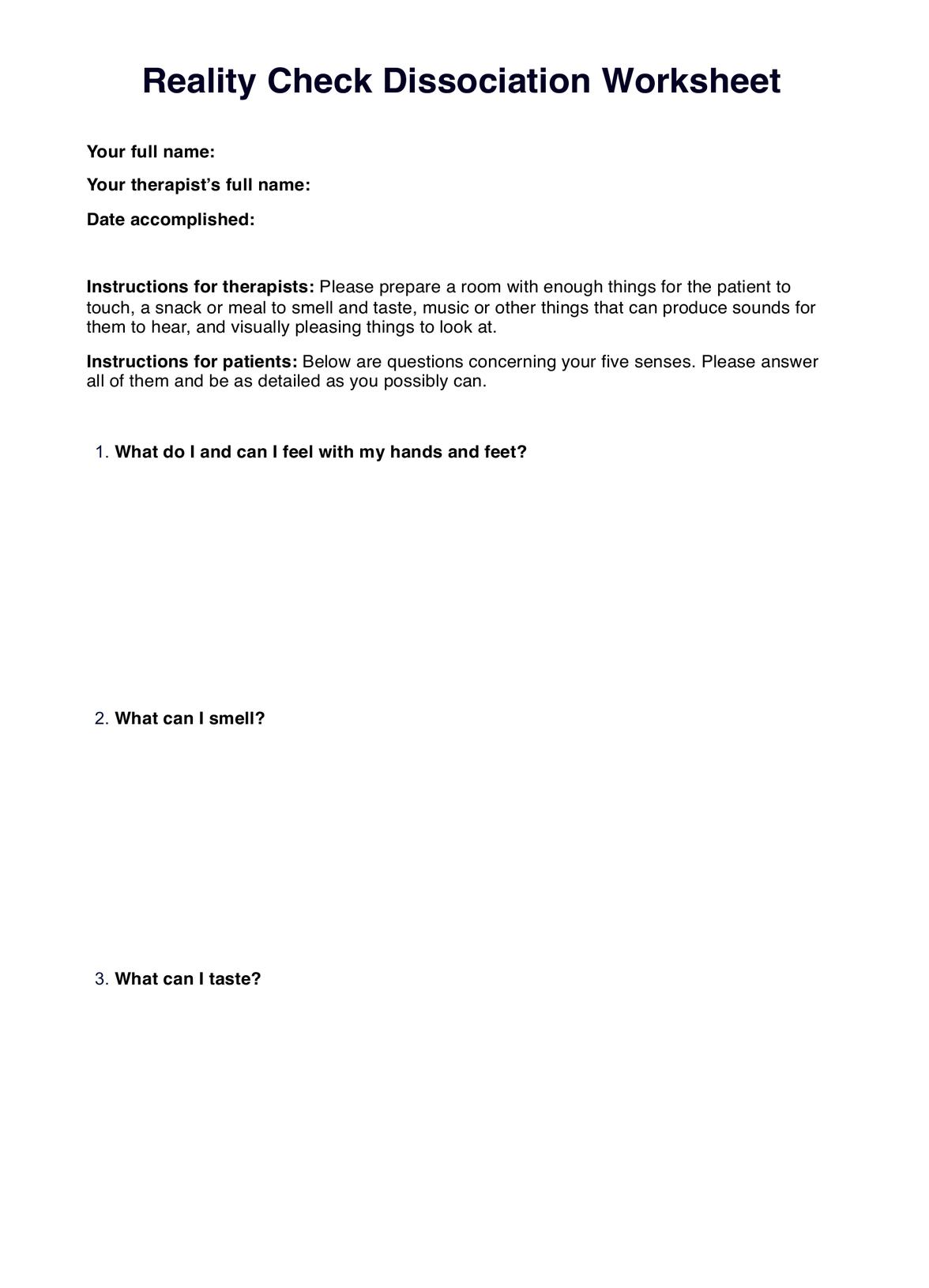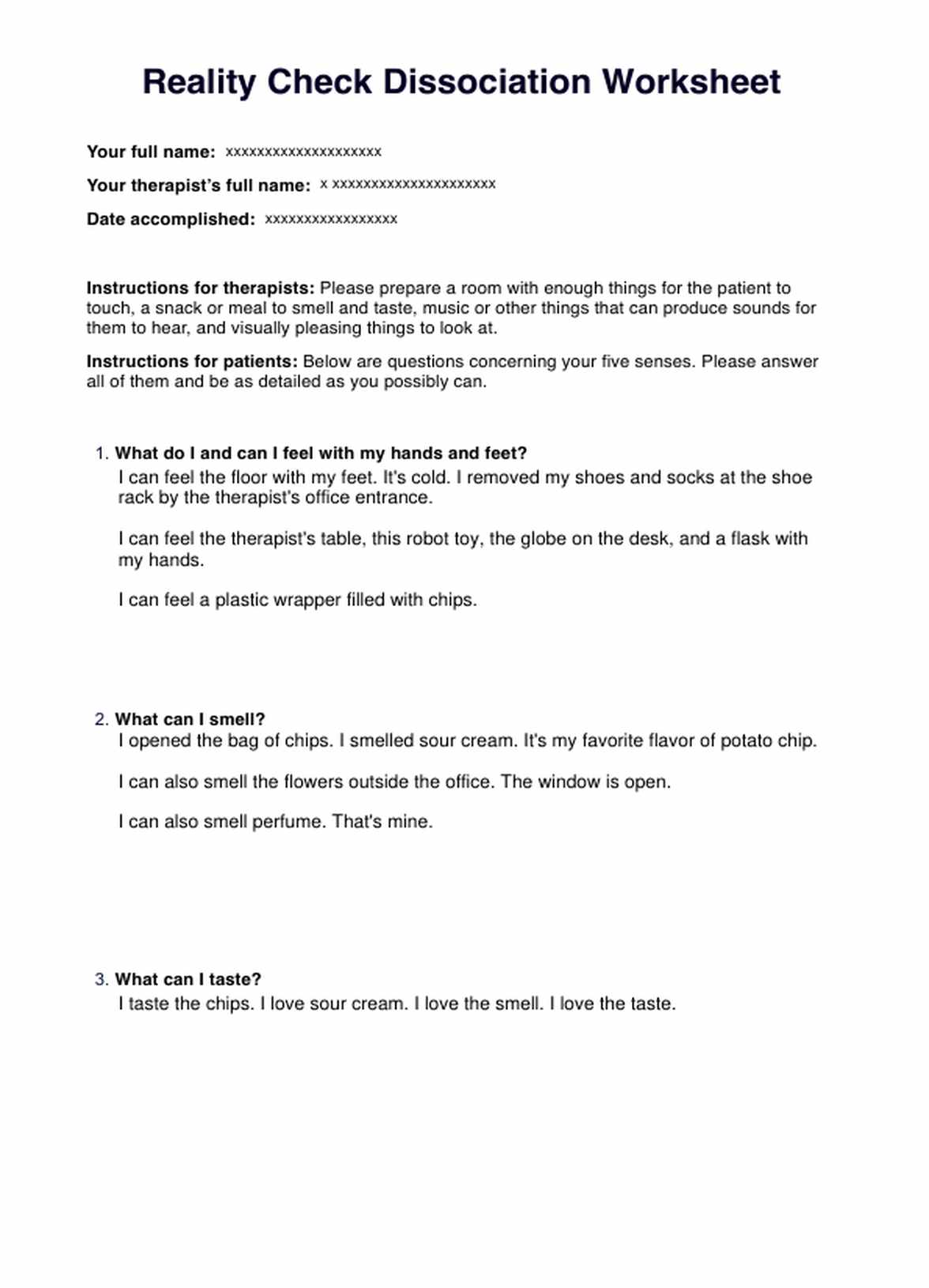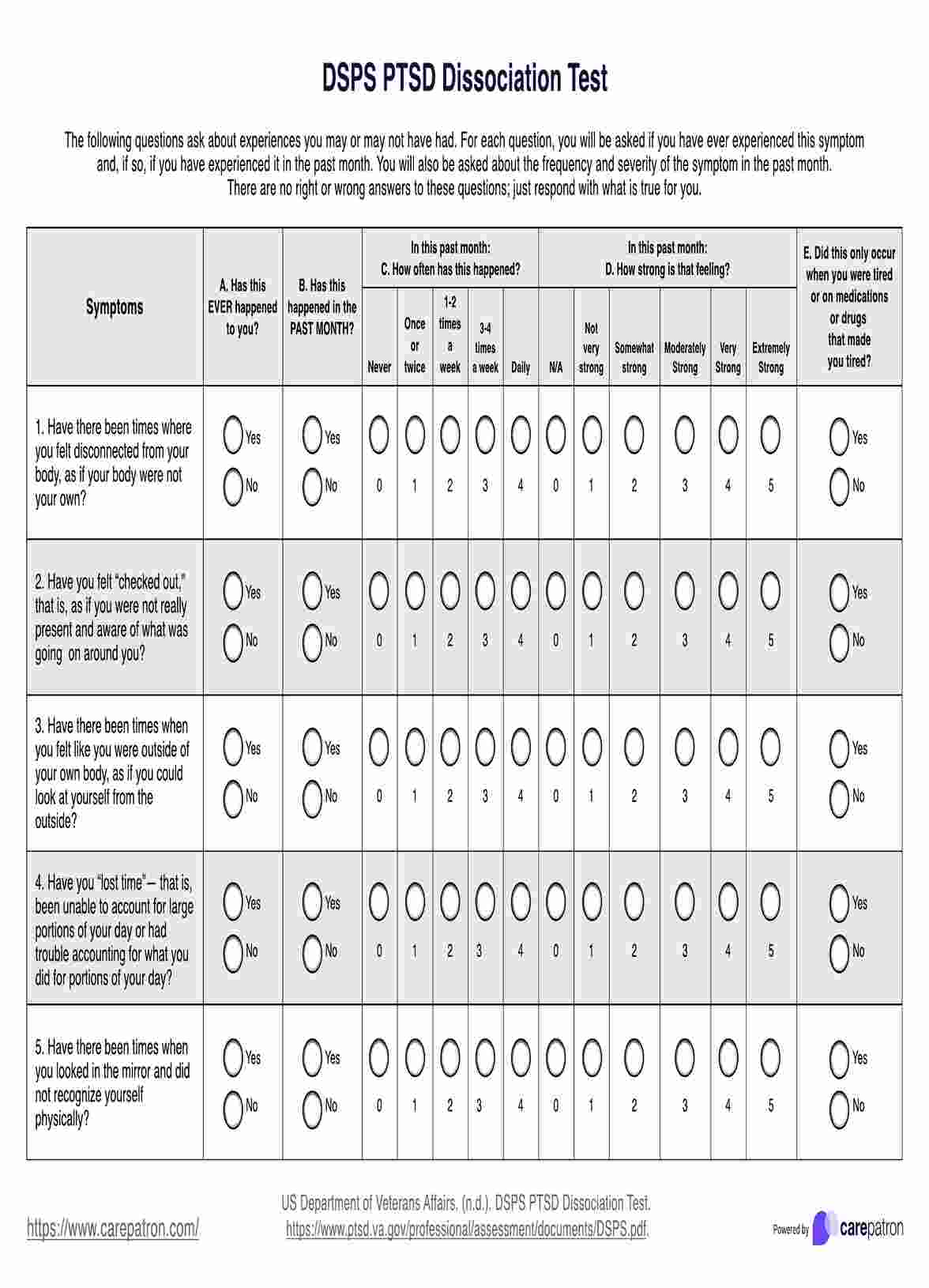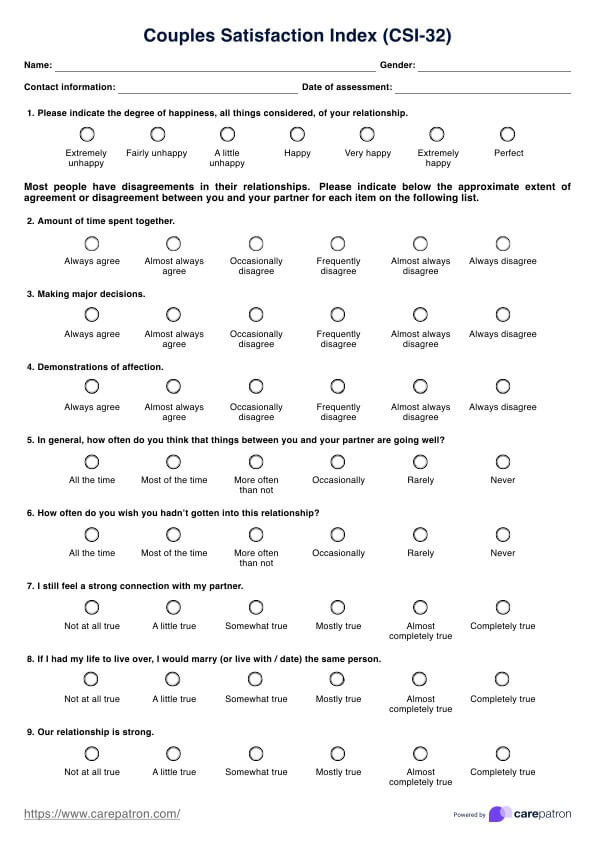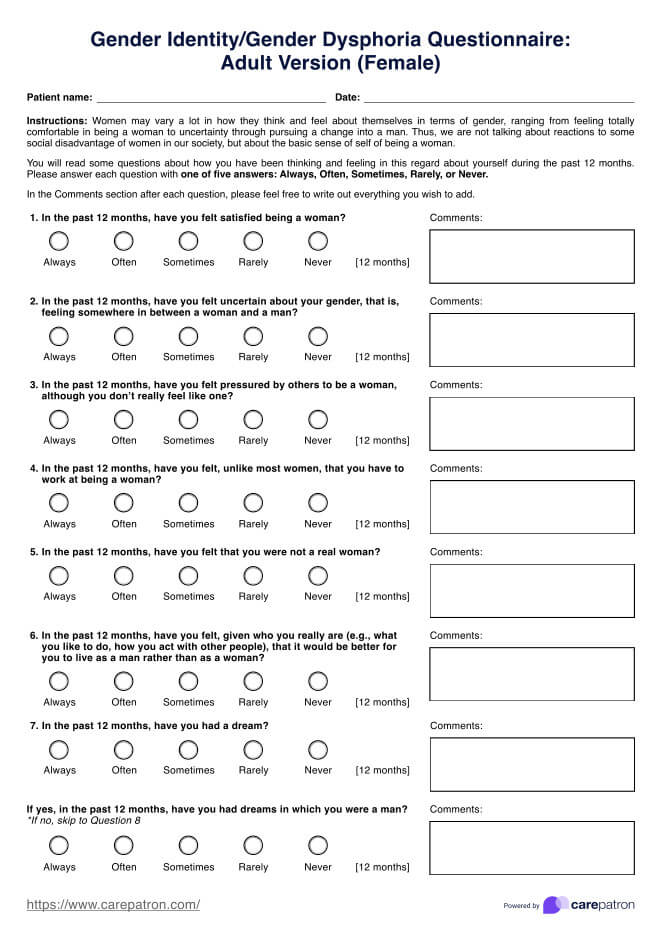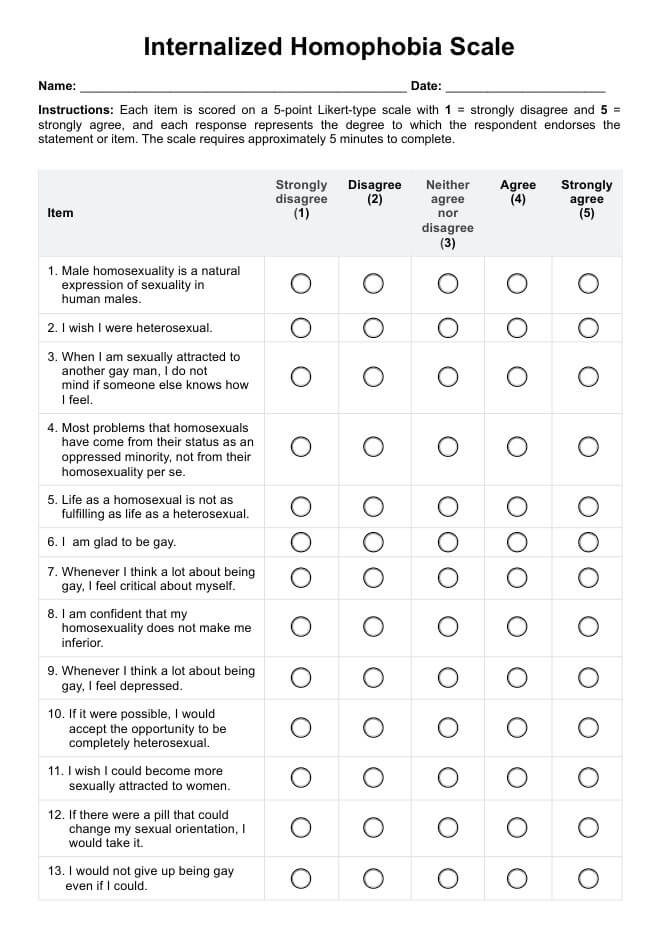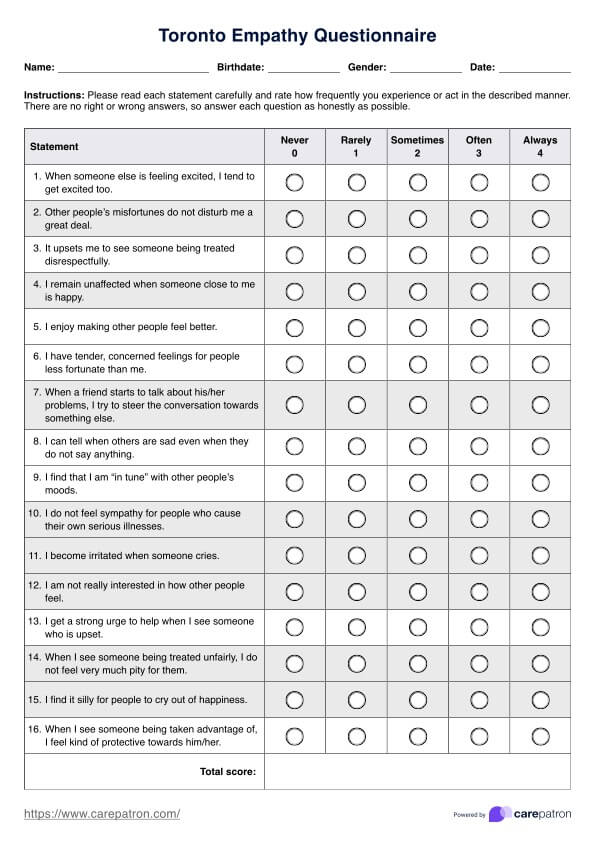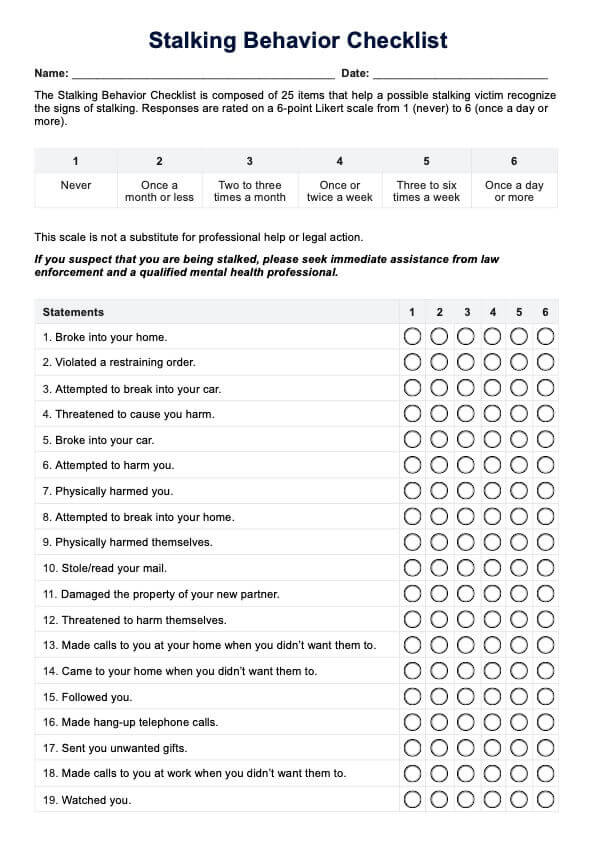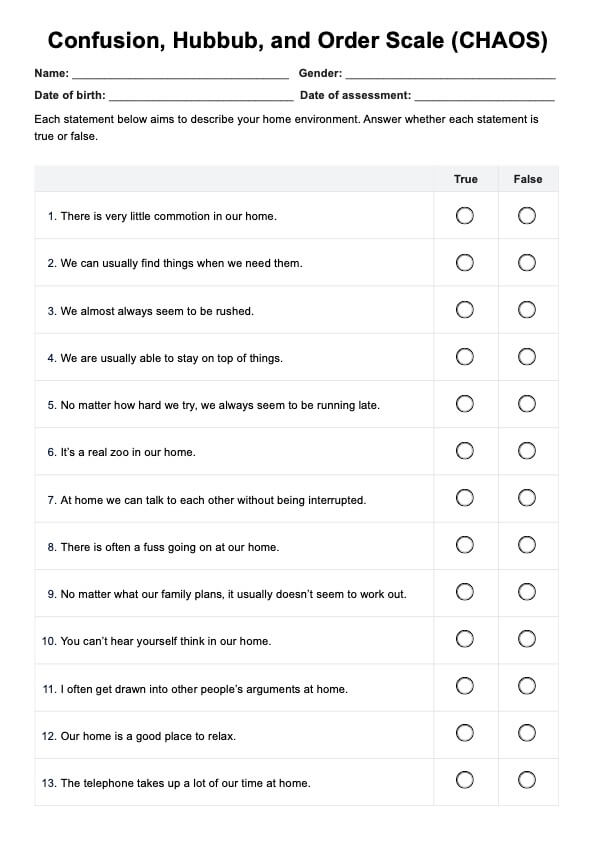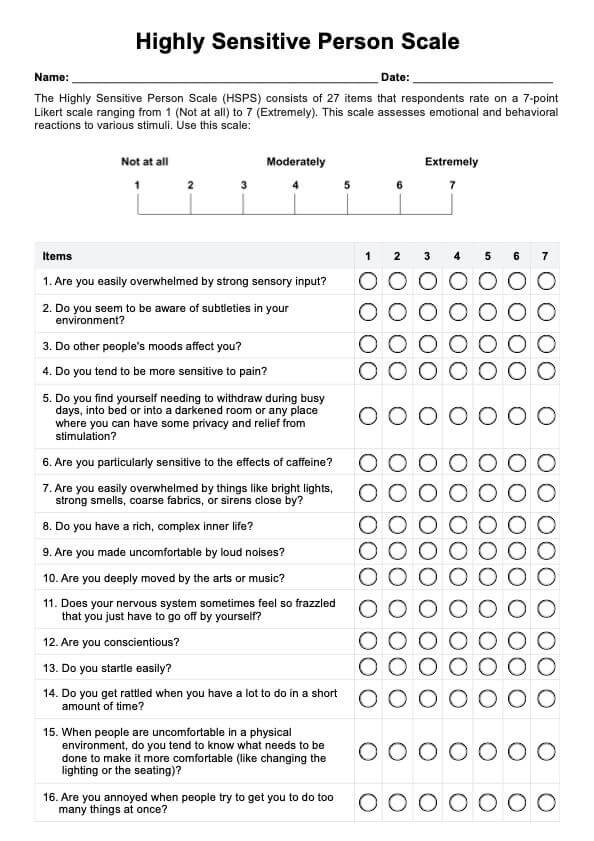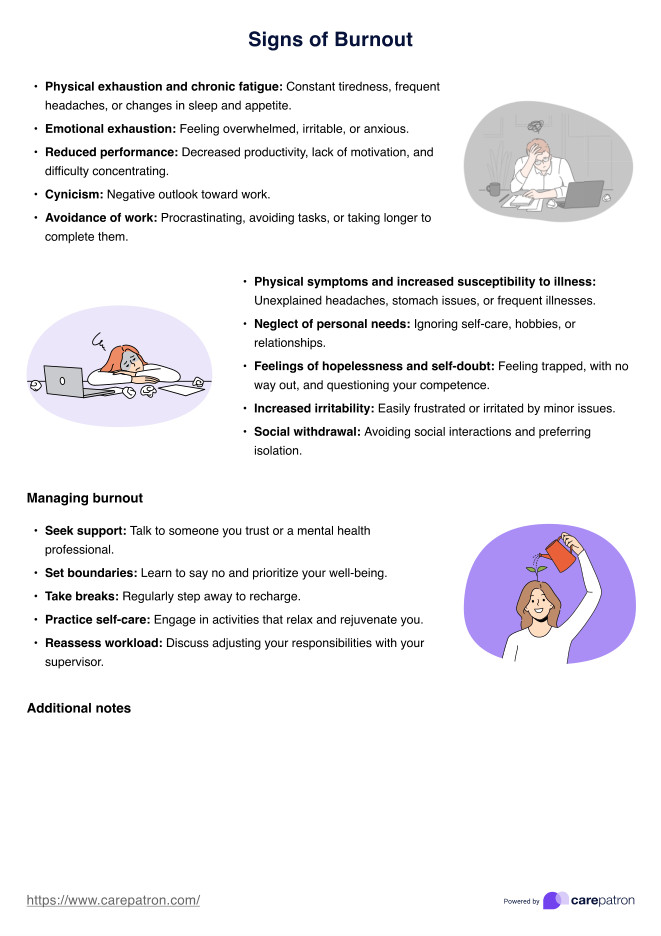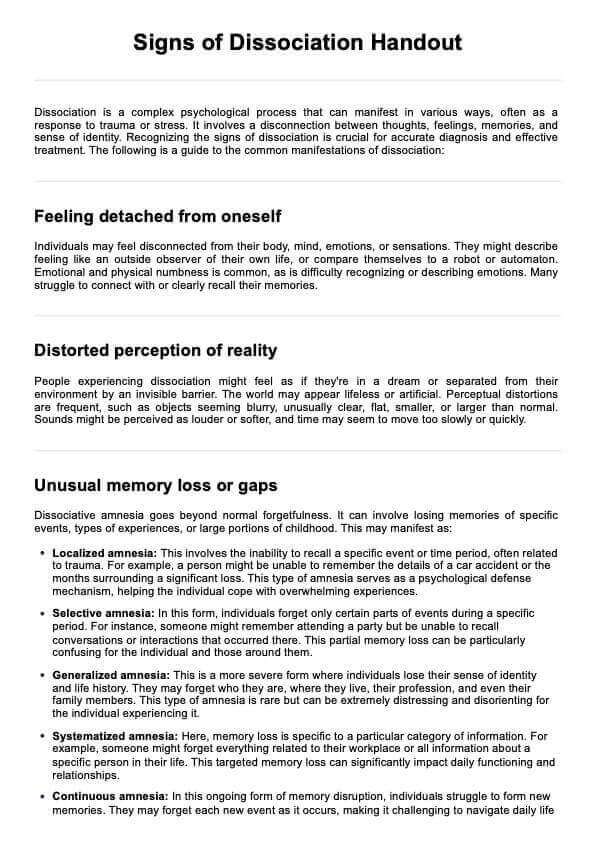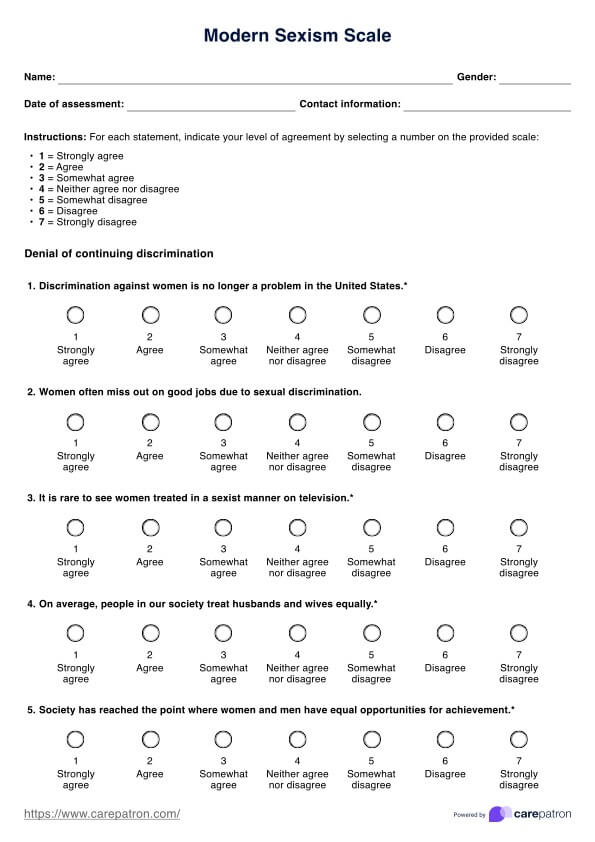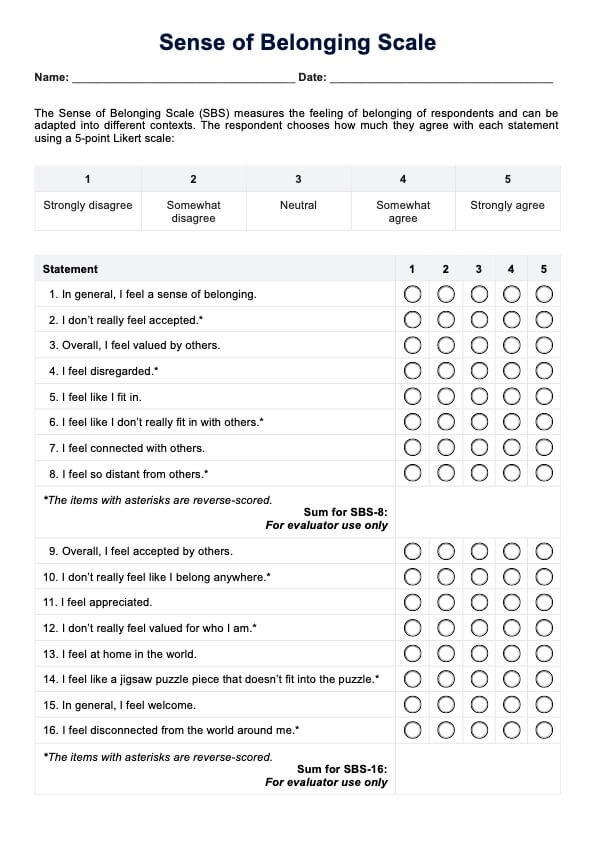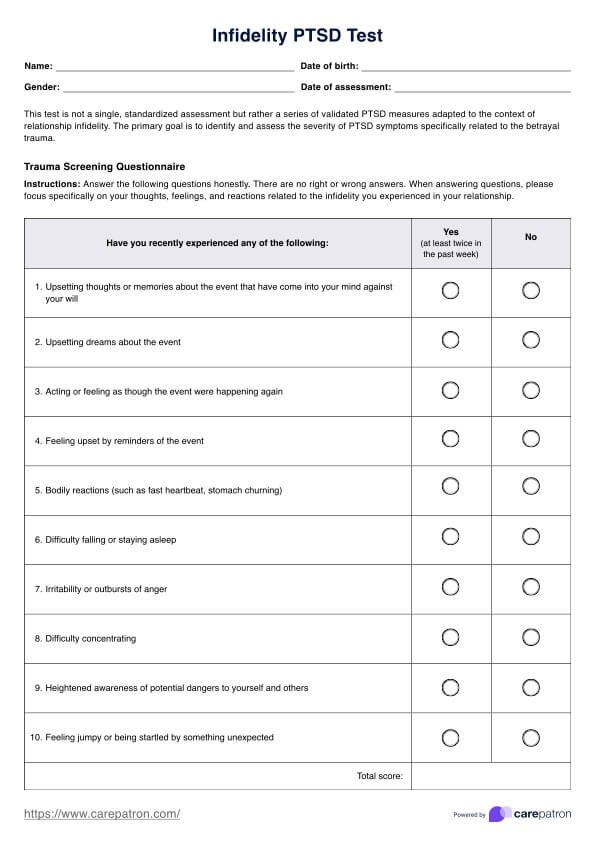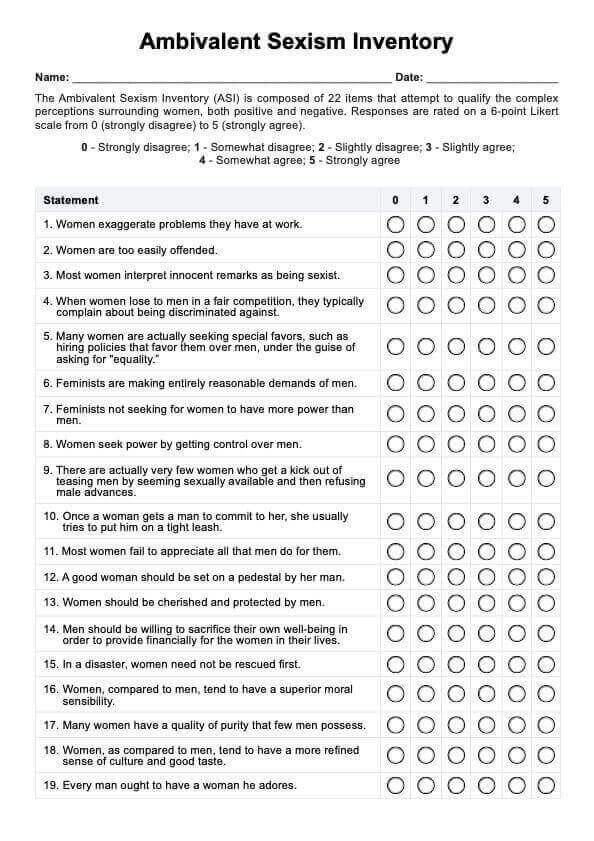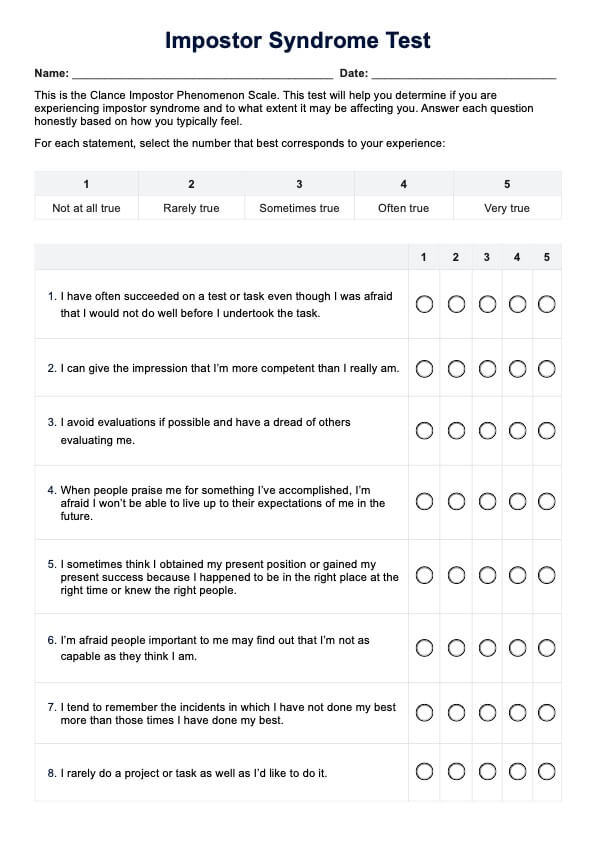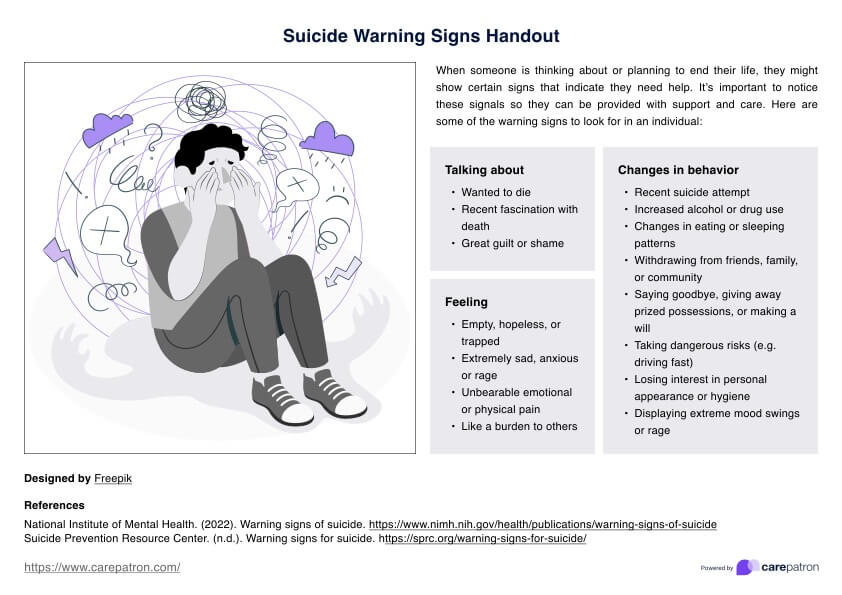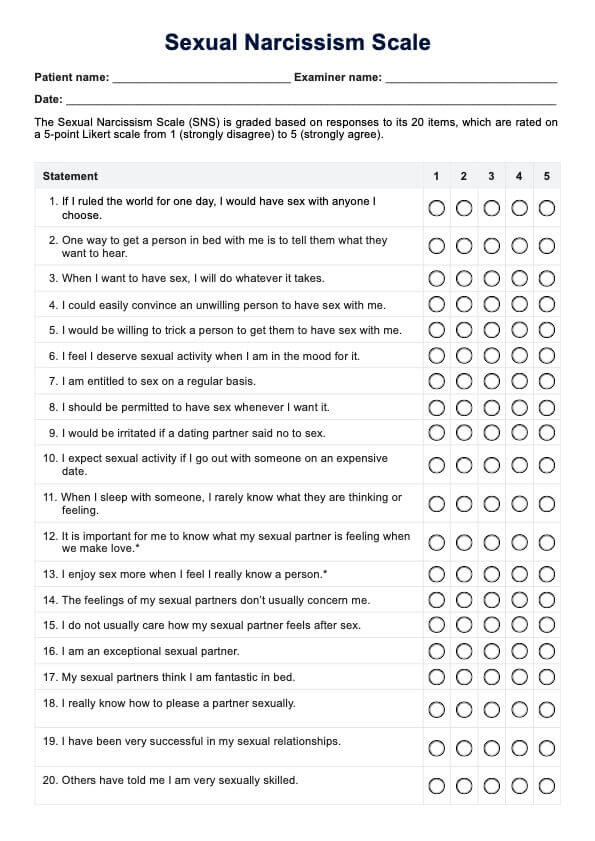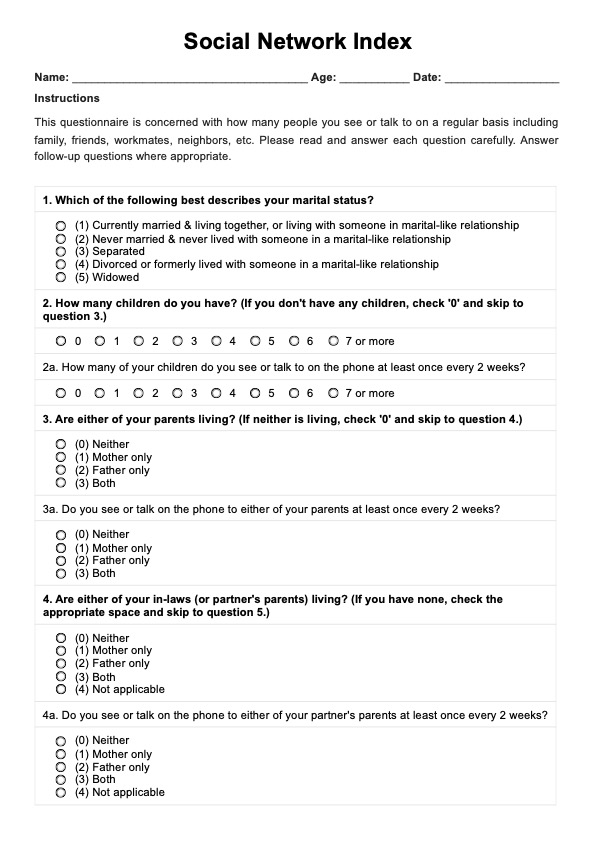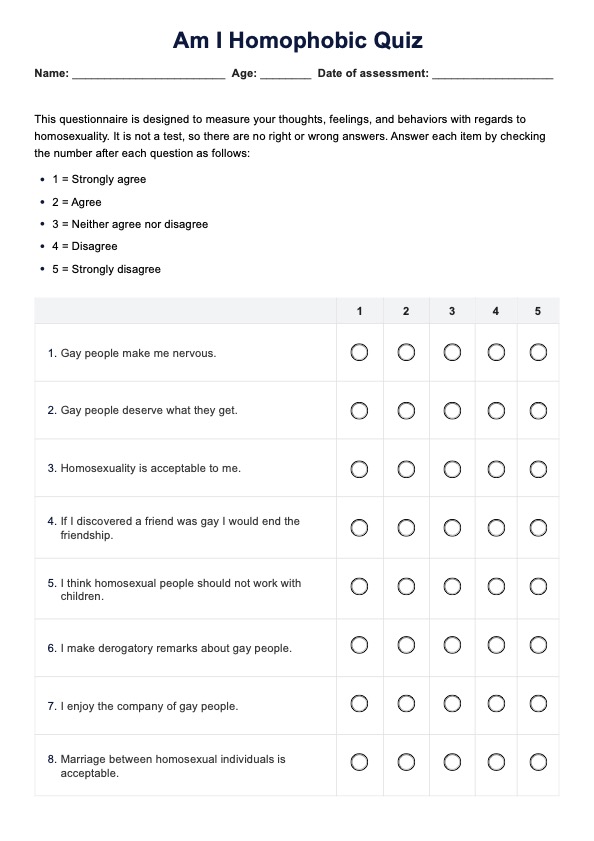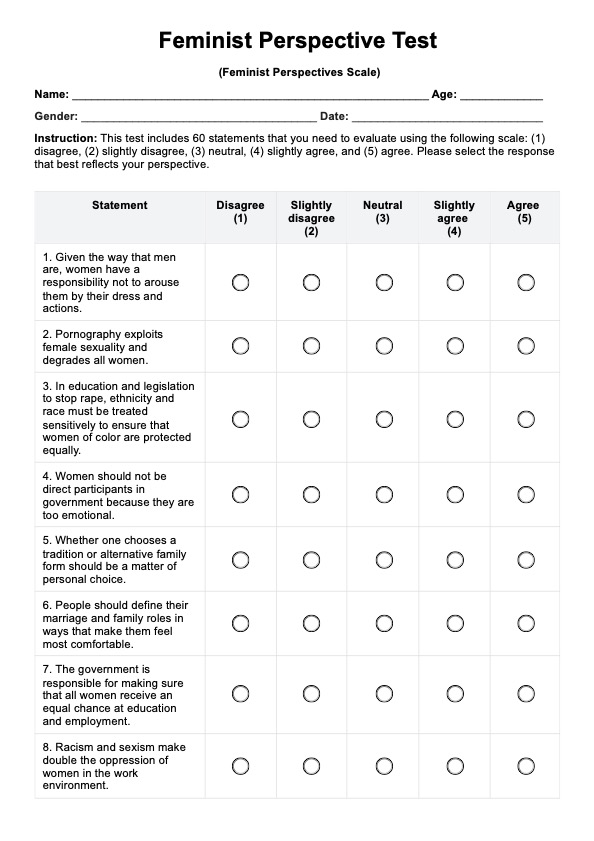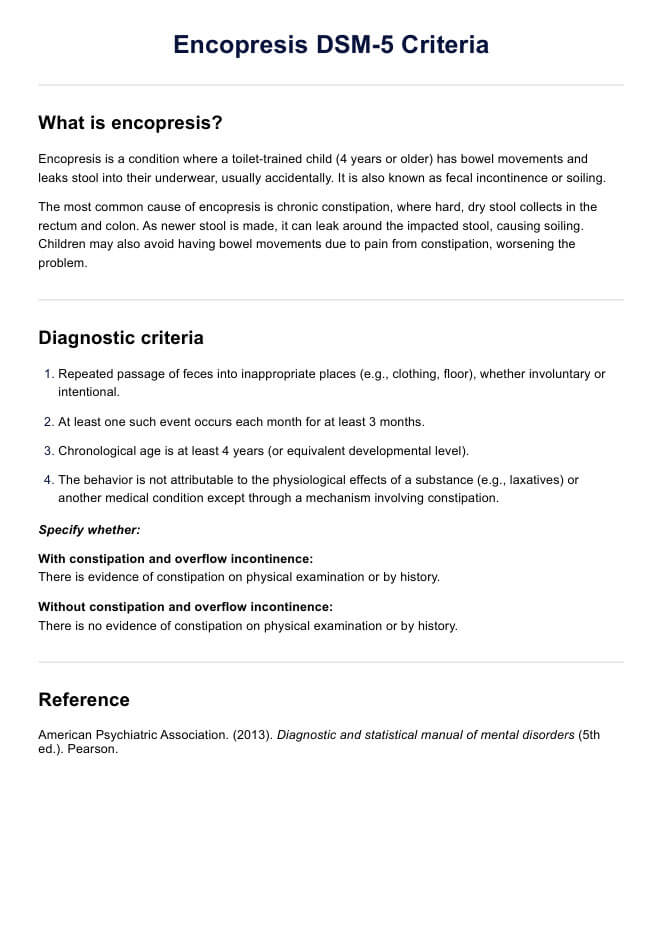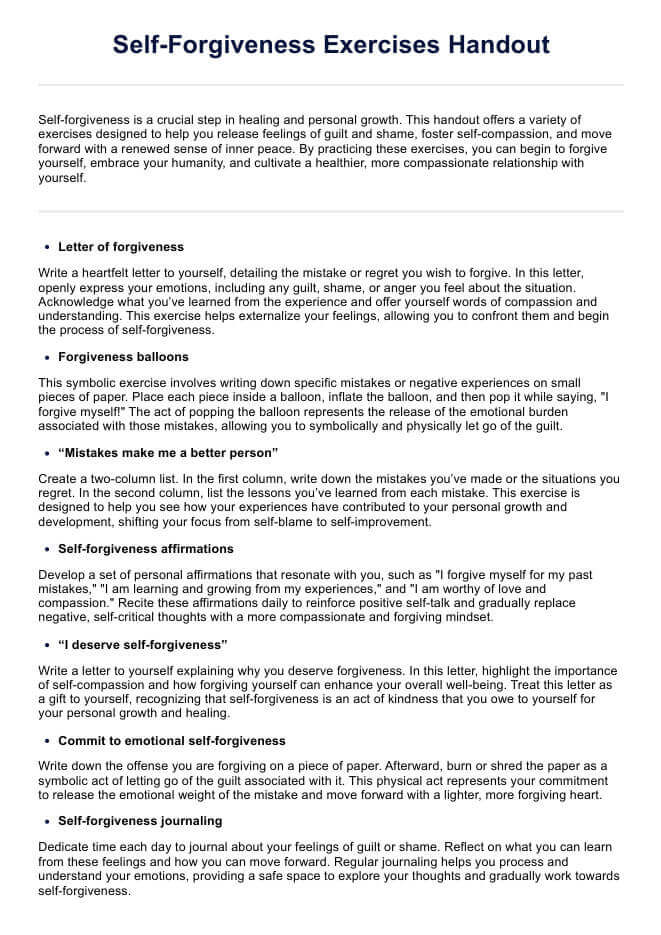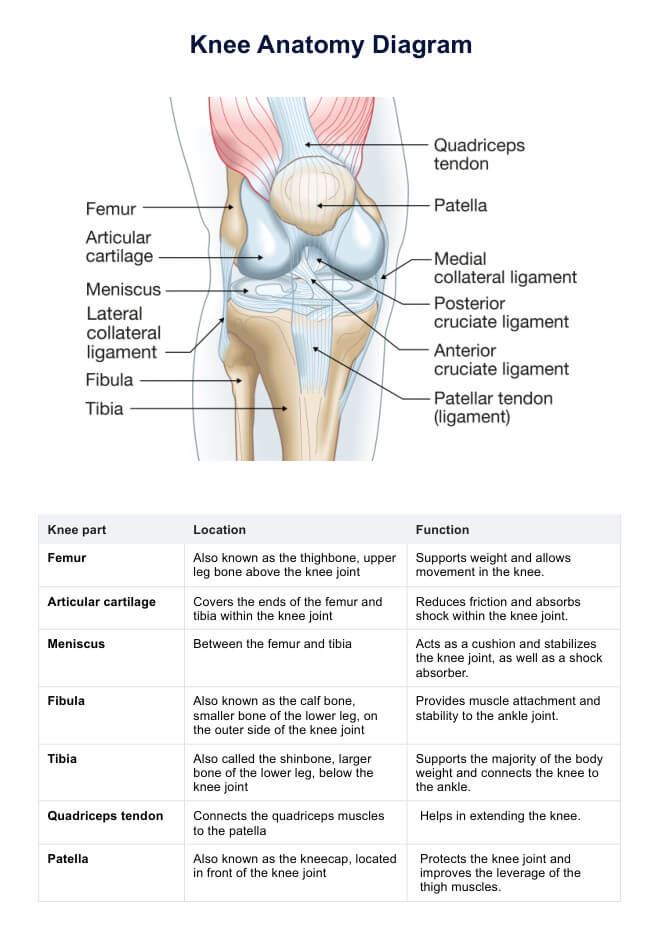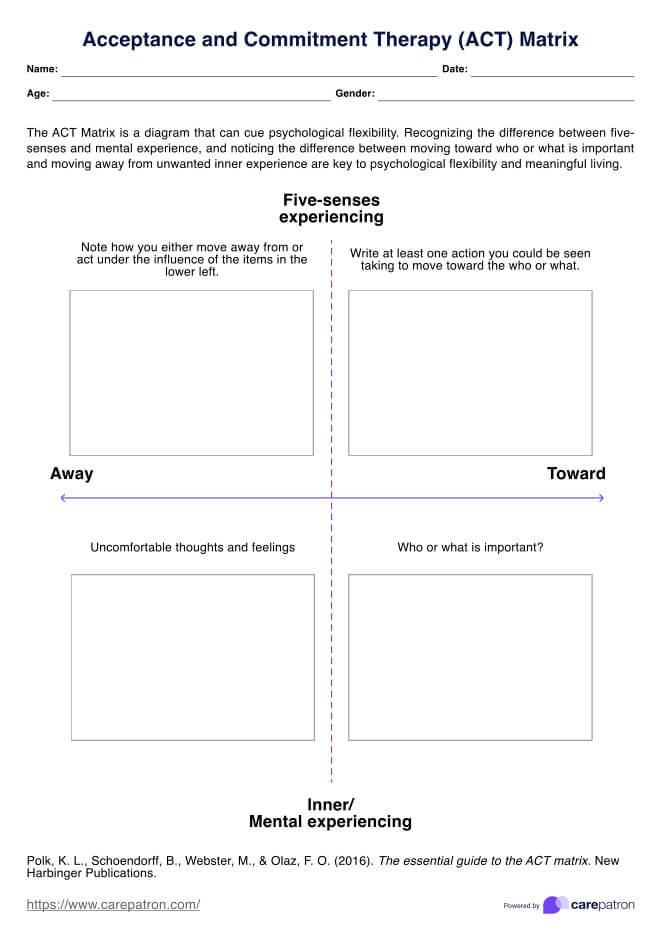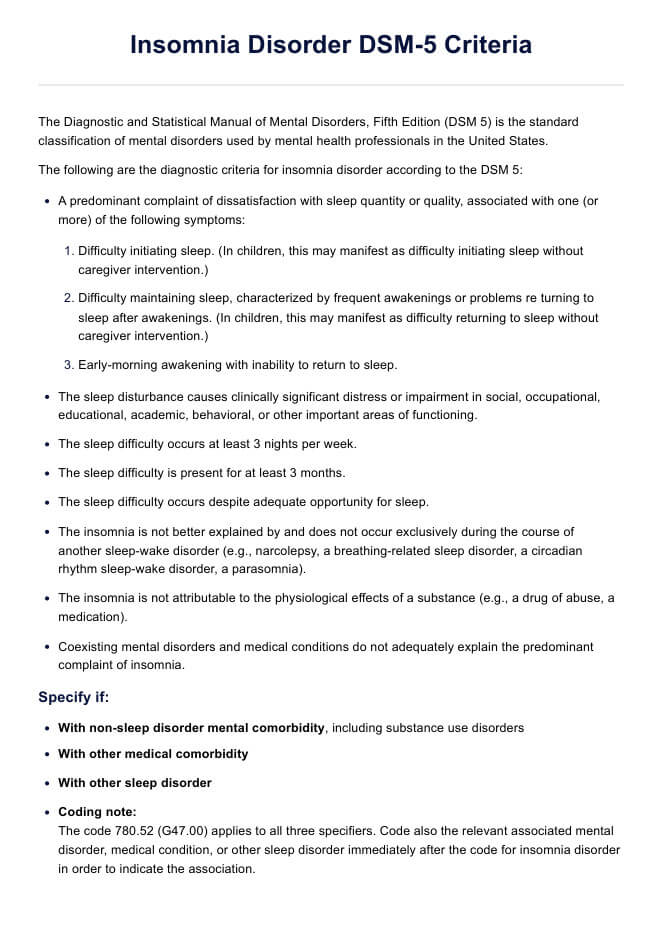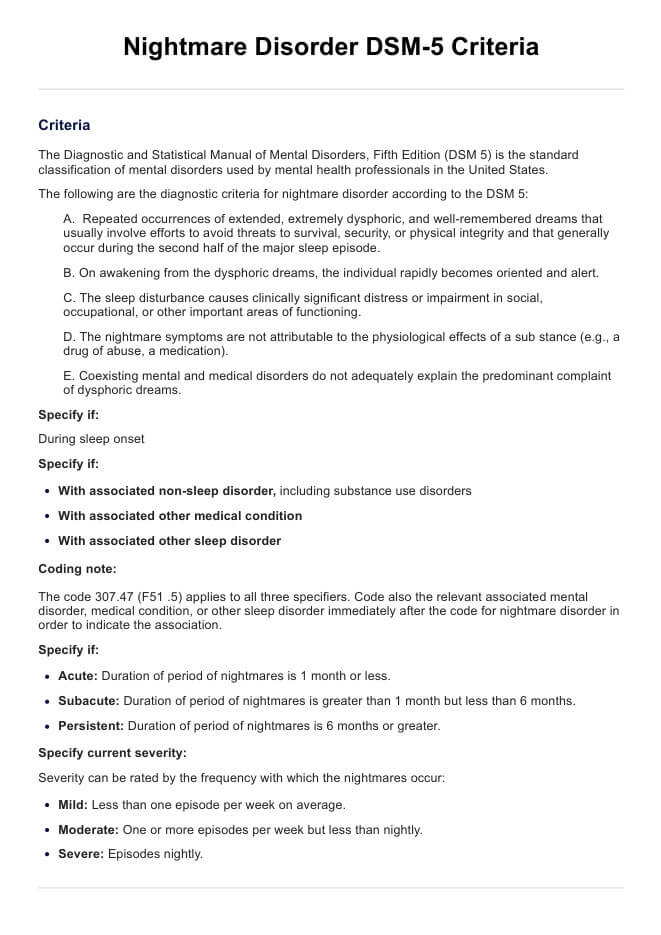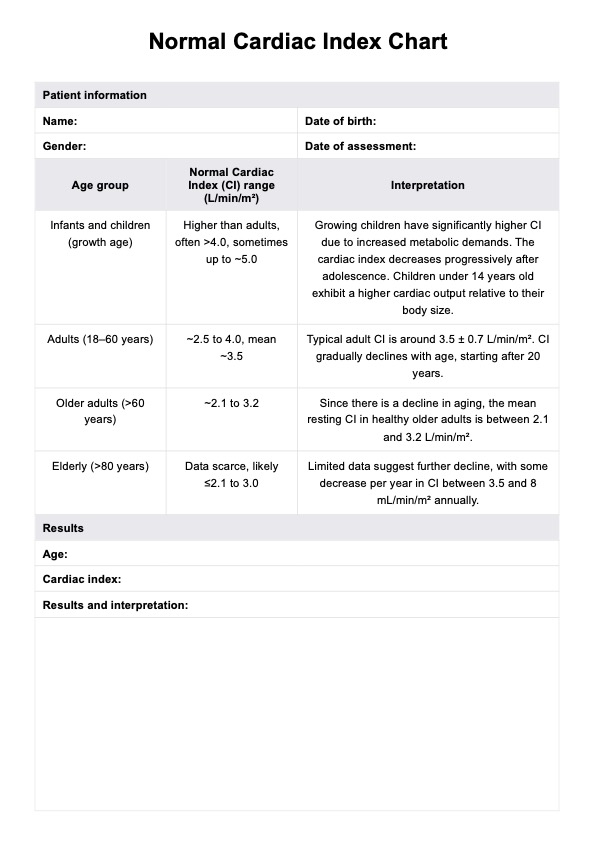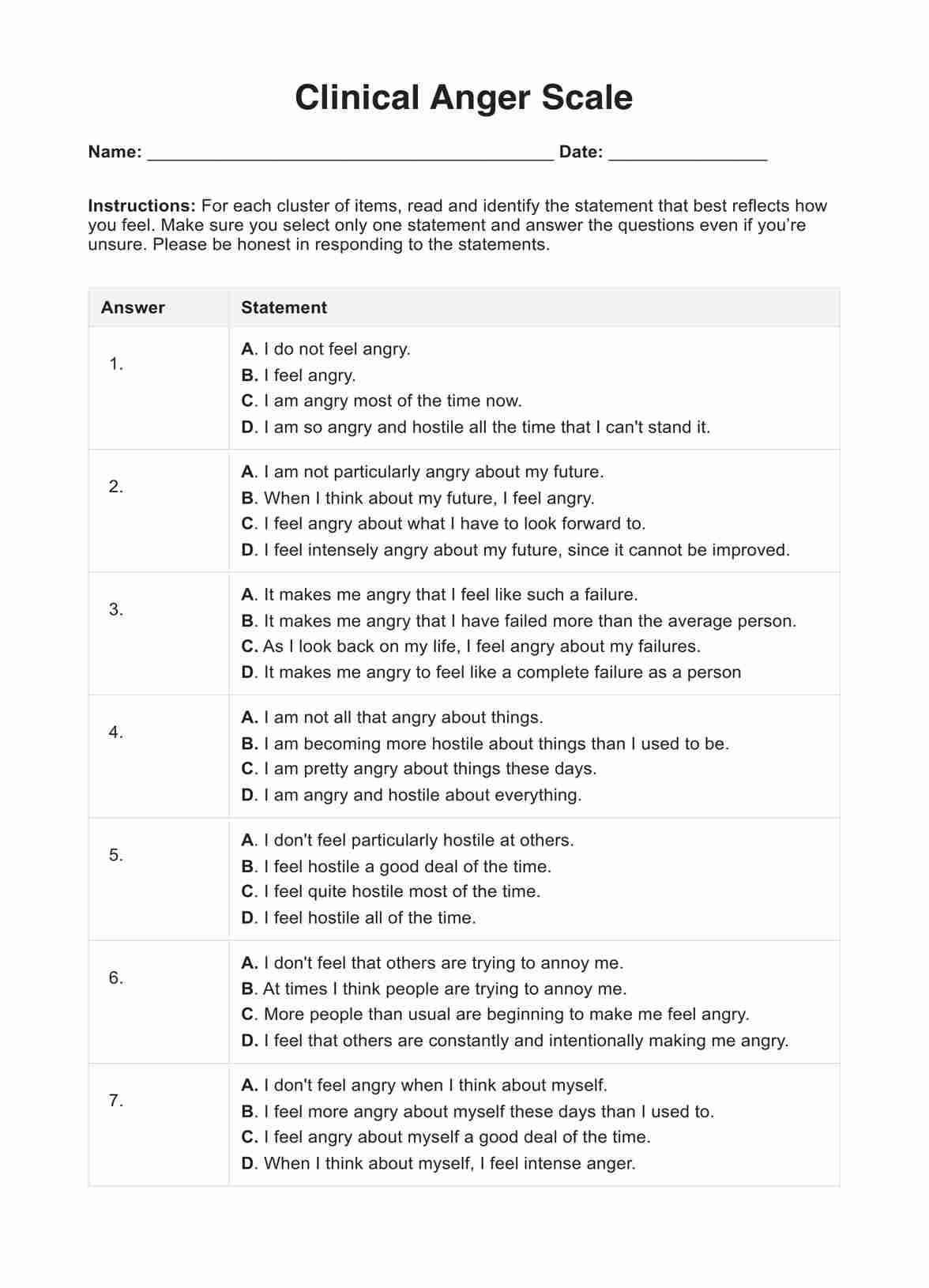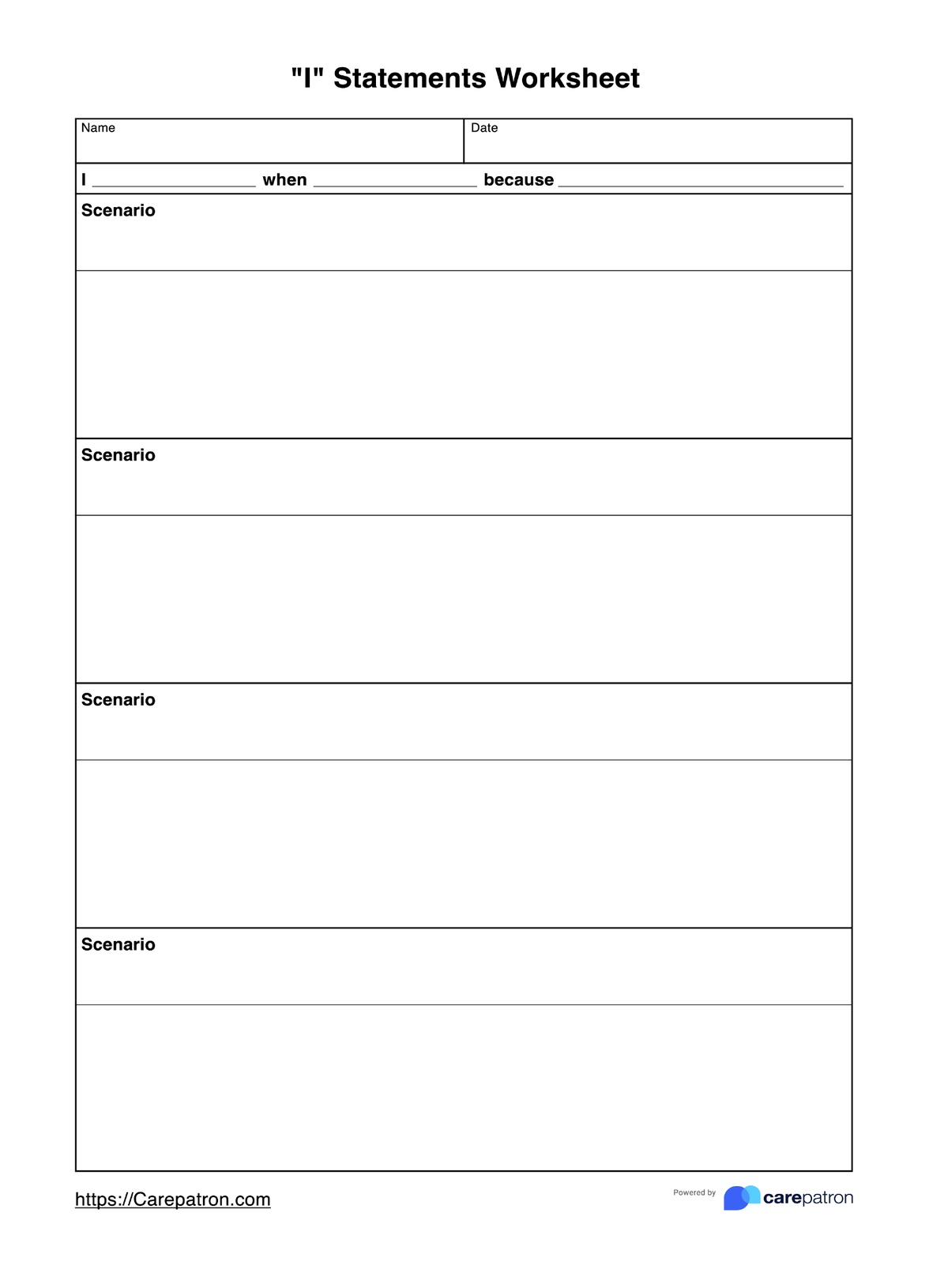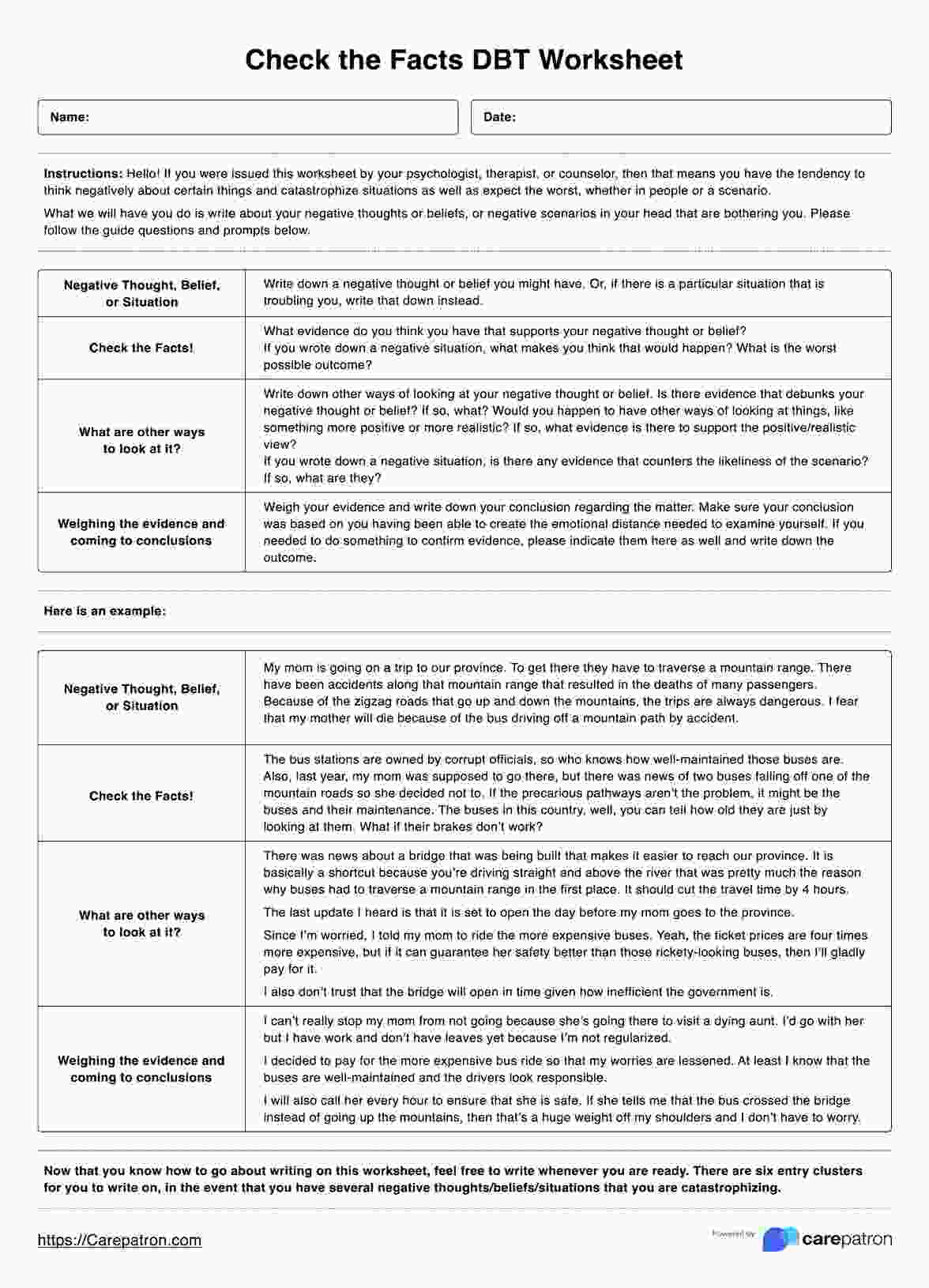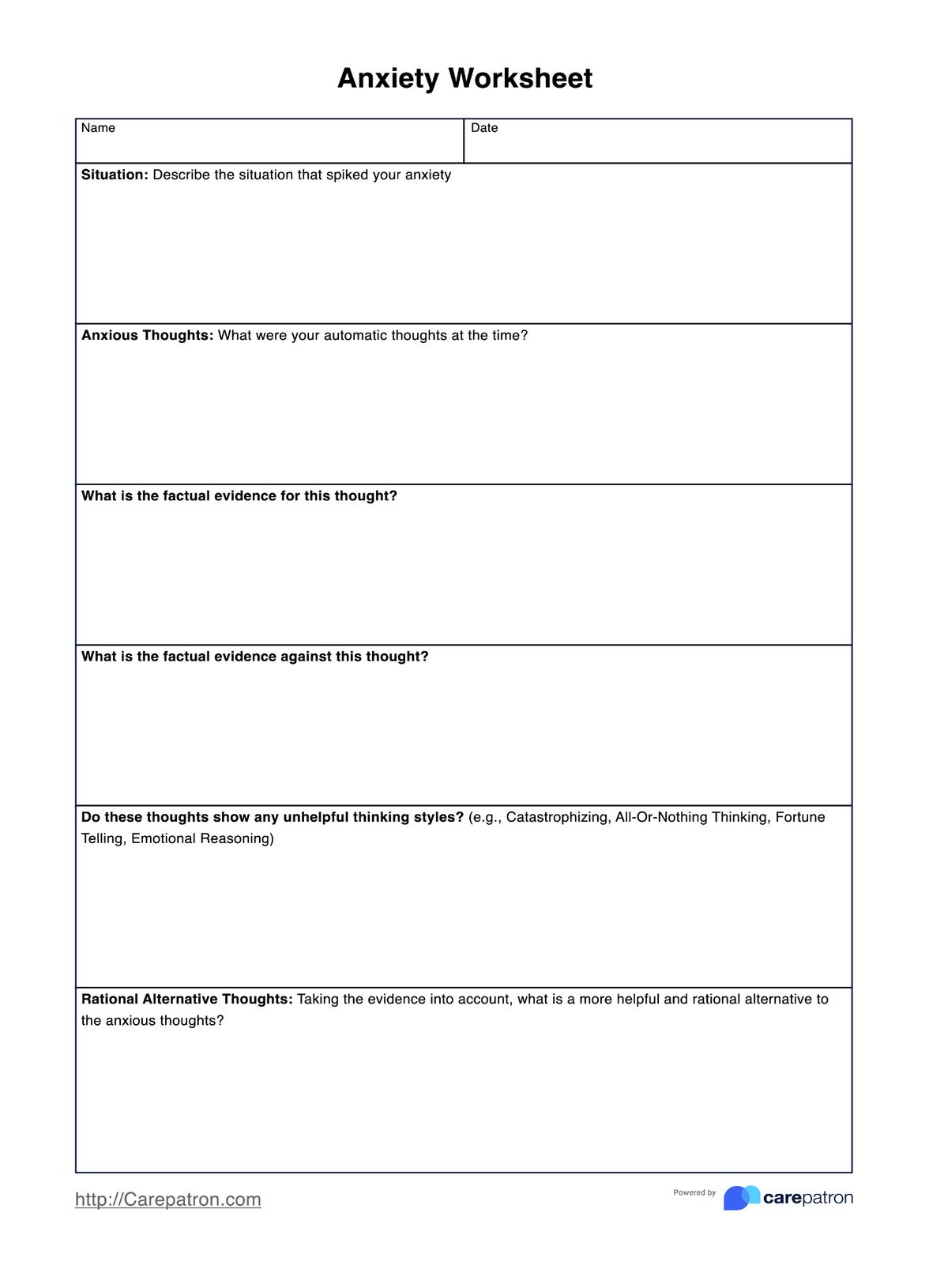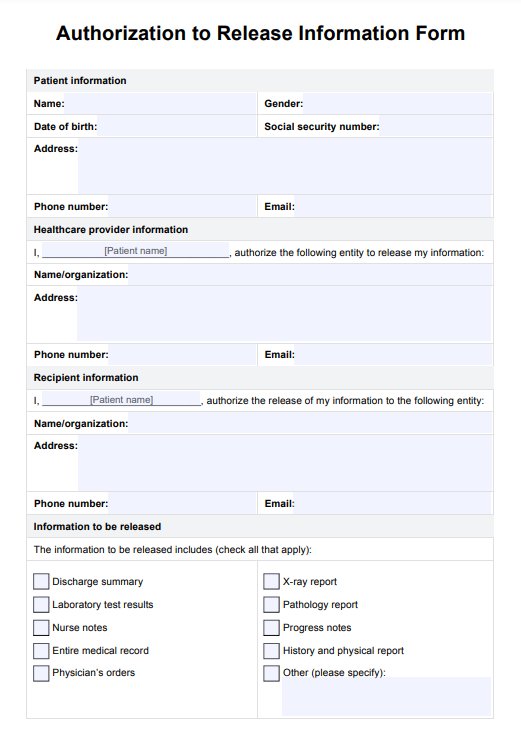Dissociation Worksheet PDF
Learn about dissociation and use this Dissociation Worksheet to help yourself or your patients snap out of a dissociated state.


What is dissociation?
In the context of mental health, dissociation refers to a mental state that a person can enter, and it is characterized by being disconnected from one’s surroundings, thoughts, and feelings. Those who dissociate can sometimes feel disconnected from their own identity, and they might even not remember anything while they are dissociating (there will be gaps in their memory when they snap out of their dissociated state).
The dissociating person will likely feel that their senses of time and space are warped. They might also become physically and emotionally numb, their immediate environment might become blurred, and they might feel like they’re in a dream. They might feel like nothing is real, even if they are.
Dissociation Worksheet PDF Template
Dissociation Worksheet PDF Example
Who experiences dissociation?
Most people experience dissociation in some shape or form. Some of us daydream in class or while working. Those who love reading tend to get lost in their imagination while reading a book. Those who love playing video games sometimes get so immersed in their video game that they forget they live in the real world for their gaming session.
Those are mild cases of dissociation, though. There are severe cases of dissociation, and those who experience this are people who have Post-Traumatic Stress Disorder as a result of sustaining significant trauma from overwhelming, distressing, and horrifying experiences.
Those who experience severe dissociative episodes tend to have their life disrupted by it, rendering them unable to follow through with routines and responsibilities, like activities of daily living, school work, office work, and even activities they enjoy.
Some people become so scared of their dissociated states that they resort to self-destructive behavior to snap out of it.
What are the signs and symptoms of dissociation?
Those who have dissociative experiences, especially the severe kind, will likely have the following symptoms:
- They will experience depersonalization, meaning they feel disconnected from their bodies, that what they feel, think about, and do is not theirs.
- They will experience derealization, meaning they feel disconnected from their immediate environment and the world. Their surroundings don’t feel real and may seem distorted, foggy, or blurry.
- They might become confused about themselves in terms of identity. They might even forget their personal information, significant memories (especially traumatic ones), and life milestones.
- They might even develop other personalities and take on different behaviors, tones of voice, or mannerisms, depending on the active personality. These personalities might even have differing and conflicting goals.
- They might lose track of time and even do activities they forget after snapping out of their dissociative state.
How is dissociation diagnosed and treated?
The diagnostic process for dissociation will be conducted by mental health professionals, specifically psychologists and psychiatrists. These professionals will first gather information about a person’s dissociation symptoms, experiences, emotional responses, and history. They can do so by interviewing the patient and their family, friends, colleagues, partner(s), or anyone who has suspected or observed their dissociation.
They must also evaluate patients using standardized clinical assessments to assess their dissociation symptoms and severity.
Examples of such assessments include the Dissociative Subtype of PTSD Scale (DSPS) and the Dissociative Experiences Scale (DES).
The former asks them questions revolving around dissociative experiences and asks them to indicate if a specific experience happened to them. If they did, they would indicate how often they experience it, especially if it happened within the month they’re being evaluated.
The latter lists several dissociative experiences, and the patient answering it must indicate a percentage between 0% and 100%. These percentages represent how often these experiences happen to them, with 0% being never and 100% being always.
Another thing that professionals must do is to rule out problems like brain injuries, anxiety disorders, mood disorders, and other neurological and mental health problems.
After getting all the knowledge they can about their patients, professionals must cross-check their findings with the criteria for dissociation set by the most recent edition of the Diagnostic and Statistical Manual of Mental Disorders. They can make an official diagnosis if all the information they’ve gathered matches the criteria.
Treatments for dissociation
The most common treatment for dissociation is psychotherapy, such as cognitive behavioral therapy, and dialectical behavior therapy. The specific approach that mental healthcare professionals will employ will depend on the patient’s needs and the problems their dissociation causes.
They will also likely add trauma therapy like trauma-focused CBT to their programs because dissociation is often related to traumatic memory.
Through psychotherapy, mental healthcare professionals can help patients cope with their dissociation in healthy ways by educating them about coping skills, mechanisms, and techniques they can use whenever they find themselves dissociating.
Such helpful skills are important for the healing process because if they can cope healthily instead of resorting to self-injury or other problematic behavior like substance abuse, they can become more resilient over time and build up resistance to their dissociation triggers.
Examples of such techniques include grounding techniques, which focus on the here and now to anchor a person to the present moment. Grounding techniques involve the use of our five senses. These senses create direct connections between us and our immediate surroundings, and they help us become aware of reality. People who dissociate can benefit from grounding techniques because they can help them keep them from feeling like they’re not in their bodies.
How to use our Dissociation Worksheet PDF
This worksheet’s purpose is to serve as a reality check for patients. It requires a person to be inside a room where they can use all five senses. Once they’re in a room where they can use their five senses, they must feel with their senses and answer the following questions:
- What do I feel with my hands and feet?
- What can I smell?
- What do I see in front of me and around me?
- What can I hear right now?
- What can I taste?
After answering those five questions, they must answer: “What do I feel right now?” This is their opportunity to detail what they feel after anchoring themselves to the present moment and contrast it with how they felt before focusing on the here and now.
When should this worksheet be used?
This worksheet can be used during a therapy session or at home!
If this worksheet is handed to a patient to be answered during a session, the therapist or similar mental healthcare professional must prepare the following:
- Objects that the patient can feel using their hands.
- Visually pleasing things so patients can identify things other than therapy office materials.
- Open a window or play music at a light volume so they have something to hear other than the hum of an air conditioner or electric fan.
- Something they can munch on so they have something to smell and taste.
If this worksheet is handed to a patient to be done at home, the patient should have similar things that a therapist must prepare to make the reality check more personalized.
What are the benefits of using this Dissociation Worksheet?
It’s an opportunity to teach a patient grounding techniques
Earlier, we mentioned that grounding techniques focus on the here and now to become anchored to the present moment. This worksheet embodies that because it asks people to use their five senses.
If a patient has never heard of or tried grounding techniques, this can become a good gateway. If they mention that this technique works well for them whenever they have a dissociative episode, therapists can teach them other techniques and exercises.
It can serve as a regular exercise for patients
Speaking of being a vehicle for educating patients about grounding techniques, this worksheet can be reused repeatedly. Earlier, we mentioned that it can also be used at home. This means patients can make multiple copies of the PDF if they wish. This allows them to continue to practice the grounding activity that this worksheet asks people to do until they arrive at the point where it becomes second nature to practice it without having to write on the worksheet.
When grounding techniques become routine, they can now respond immediately and healthily to dissociative episodes.
Therapists can understand patients better through this worksheet
Since this worksheet asks people how they feel before and after the exercise, therapists can learn how dissociation affects their patients and how much relief they feel after practicing coping skills and mechanisms like grounding techniques. This allows therapists to explore other coping mechanisms that might benefit their patients.
Other useful resources for dissociation
Earlier, we mentioned that there are assessments that mental healthcare professionals can use to evaluate patients for dissociation, one of which we linked earlier: the Dissociative Experiences Scale.
Besides that, we also have two other resources you can take advantage of. One of them is the Dissociative Identity Disorder Test, which is a self-report assessment that asks patients to indicate how often statements like the following apply to them:
- At times, I cannot recall some important events of my life.
- Some places which should be familiar to me appear completely unknown and strange.
- I have dialogues with another identity within myself.
- When I am alone, I converse out loud with myself.
- People inform me of conversations I've had but I have no memory of them.
- I hear voices in my head that are not my own.
We also have another worksheet called the Logging Dissociation Worksheet, which asks patients to detail their dissociative experiences by answering the following questions:
- What happened before you started dissociating? What triggered your dissociation?
- What did you feel and think about while you were dissociating?
- Were there any bodily changes/sensations and behavioral changes while you were dissociating?
- Did you find ways to cope? If so, how did you cope?
Also, using this dialectical behavior therapy template can uplift your practice and improve client experiences.
Why use Carepatron as your therapy software?
Thanks for reading this guide! We hope this was an excellent refresher to dissociation. We hope our Dissociation Worksheet can help you or your patients anchor to the present moment to combat dissociative episodes.
While you’re still here, we’d like to ask you for your time to check more of the Carepatron platform if you haven’t. We have various nifty features that can improve and streamline your work, and we’re confident they’re cool enough that you’ll consider us your number-one psychiatry EHR and therapy practice management software. We won’t detail these features here, but we’d like to highlight one: our resource library.
Our resource library houses a massive collection of clinical and non-clinical resources that cover numerous healthcare fields, topics, and practices, especially mental health.
Earlier, we mentioned that before diagnosing a patient with dissociative disorder, they must rule out other problems first. We have assessments that can be used to assess patients for other mental health issues like depression, anxiety, psychological distress, eating disorders, etc.
Given that dissociation is often associated with trauma, we also have an abundance of worksheets for cognitive behavioral therapy that can help patients apply any coping techniques they’ve learned, like cognitive restructuring and de-catastrophization.
What’s great about these resources is that they’re all free, so feel free to read as many guides as you want and download as many resources as you need! We hope they help you cover more ground with your work!

Commonly asked questions
No. Trauma is the most common trigger, but it’s not always the cause of it. Being fatigued or dealing with specific stressors can cause dissociation.
Yes. These can contribute to dissociative experiences, but they are temporary and resolve on their own when the effects wear off.
That depends on the severity. Dissociation can disrupt a person’s day and prevent them from doing what they must do. Extreme cases can result in risky and destructive behavior like self-harm, reckless driving, not looking both ways while crossing the street, and substance abuse.


